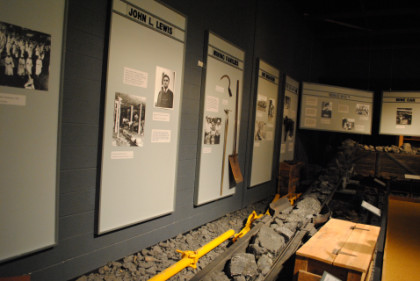I arose at the Radisson and drove to the Walmart in Dickinson City then stopped by McDonald's for hot cakes and sausage before returning to the hotel. I wrote yesterday's story before checking out and drove to the Anthracite Heritage Museum. This was the day of the NRHS Board and Advisory Council meetings so there were no event planned.
On the way there I caught a Delaware-Lackawanna train on the Lackawanna River bridge.
The Central Railroad of New Jersey and New York, Ontario and Western station built in 1891. From here I drove out to the Anthracite Heritage Museum.
The Anthracite Heritage MuseumCreated in 1971, the Anthracite Heritage Museum, located in McDade Park in Scranton, serves the educational needs of the public regarding the story of hard coal mining, its related industries, and the immigrant culture of northeastern Pennsylvania. The Museum tells the story of the people who came from Europe to work in the anthracite mining and textiles industries.
On a tour of the facility, visitors will experience the lives of proud people who endured harsh working conditions yet carved out communities filled with tradition. The diverse collection highlights life in the mines, mills and factories. Visitors are welcomed into the family’s homes and neighborhoods with a moment of reflection in the kitchen, a visit to the pub, or a seat in a local Church.
The Pennsylvania Anthracite Heritage Museum's diverse regional collections represent all facets of work, life and values of the region's ethnic communities. The Pennsylvania Anthracite Heritage Museum is administered by the Pennsylvania Historical and Museum Commission and is actively supported by the Anthracite Heritage Museum and Iron Furnaces Associates which is a non-profit community based organization.
The museum from down below.
A coal mine car.
A large piece of anthracite coal. Anthracite, or hard coal, is most commonly found in northeast Pennsylvania. Anthracite coal is very different from the bituminous or soft coal found in such states as Kentucky and West Virginia. Bituminous coal contains less carbon and produces more pollutants when burned. Anthracite coal, on the other hand, is almost pure carbon and produces very little smoke or residue when being burned and provides more heat than bituminous coal. During the late 1800's and early 1900's, anthracite coal was one of the most sought-after fuels and was responsible for leading the world into industrialization. Northeast Pennsylvania contains the largest deposits of anthracite coal in the world. The Pennsylvania counties of Carbon, Dauphin, Lackawanna, Luzerne, Northumberland and Schuykill were made famous at the height of industrialization.
Anthracite Museum 30" gauge 0-6-0T 61, ex. Wayne County Historical Society donation in 191, exxx. Glen Alden Corporation 1960, exxxx. moved to Larkspur, Pennsylvania, nee Hudson Coal 61 built by Vulcan Iron Works in 1919 sits covered in front of the museum.
The main entrance to the museum. Inside I met my guide for the tour, Chester Kulesa, the Historic Site Administrator.
Coal Sculpture by C. Edgar Patience.
The title of this exhibit.
Cut logs on a cart.
Native Americans.
Discovery of Anthracite and Native Americans.
Use of Anthracite.
Transporting Coal.
Canals and Railroads.
Western and Northern European Immigrants.
New Country
In the Shadow of the Breaker.
Lifetime of a worker.
Going to America.
Eastern and Southern European Immigrants.
Reading baggage cart.
Model of Pennsylvania and Reading steam locomotive "The Earth".
Electric Mine Locomotive 1889.
A rock crusher.
More miner's equipment.
Mine Work and The Life Cycle.
Locating Anthracite and Working in the Community.
Wood Carvings about coal mining.
Mine drill.
The Anthracite Miner.
Mine engine.
Enos H. Horst Coal and Farm Supplies.
DS&S mine model rail car.
Pennsylvania Railroads map.
Model train on display.
Power generator.
A threader.
A weaver.
Another weaver.
Silk weave and bobbins.
Silkworms and silk bobbins.
A warping and circular weave.
Another weave.
A wooden weave.
Chester explaining how this weave works.
A weave.
A typical miner's home around 1935.
This is the original altar of the Immaculate Conception Church in Berwick, Pennsylania.
Religions of the coal mine towns.
A horse and cart.
Fire wagon 3.
The Garment Industry.
The miner's bar where they would wash the coal dust down their throats.
More coal mine equipment.
A mine drill.
Burschel Wagon.
Cooking ovens.
Mine engine.
More mine equipment.

Engine for conveyor belt.
Conveyor belt.
Model of the shovels used in strip mining.
The full-size bucket of that model shovel.
Mine engine.
A loaded mine coal car.
The Region Matures.
Anthracite, Enthnicity and the Region today.
A coal sculpture by Charles Edgar Patience.
An impressive wooden cross.
Charles Edgar Patience "Black is indeed beautiful".
George Washington sculpture. I thanked Chester for an excellent tour and walked out, feeling fantastic after everything I just learned.
The view looking down into the Lackawanna Valley.
Right below the Anthracite Heritage Museum is the Lackawanna Coal Mine Tour.
A mine train ride is also offered, but I did not have time to partake in it.
Tracks with mine cars.